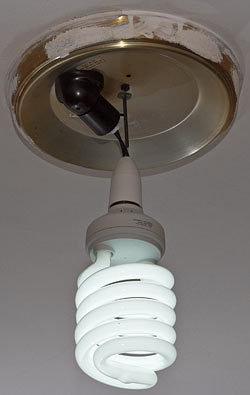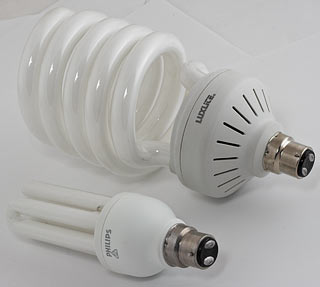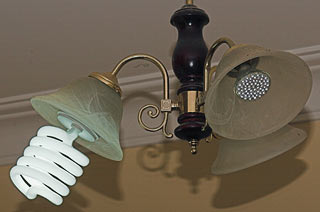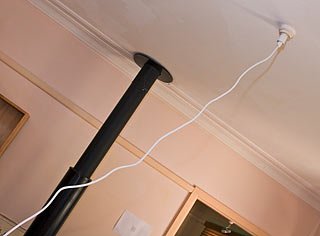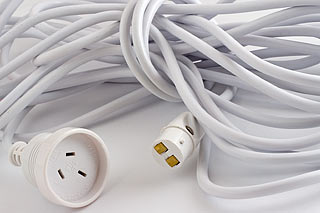How, you may be wondering, does Dan roll?
Why, thank you for asking.
As it happens, gentle reader...
...I roll like this.
That is an eighty-five watt Luxlite compact fluorescent lamp, hanging in my work/photo/junk room. I bought it from Lighting Pro Australia (actually, from their eBay store here). It cost me $AU54 delivered - only $AU39 for the lamp itself (it's $AU6 more expensive on the Web site), but it's a big fragile spiral of glass and so needs fancy packaging.
This eighteen watt, "hundred watt equivalent" Philips bulb must be feeling thoroughly inadequate. The big CFL is at least 400 watt equivalent; maybe more.
Past experimentation has shown me that CFL equivalence rules are, at least sometimes, fair enough. Bear in mind that the luminous efficacy of ordinary incandescent bulbs varies, so you don't get the same amount of light out of every "hundred watt" bulb. Also, CFLs seldom deliver their full output as soon as they're turned on; they need a few minutes to warm up and reach maximum efficiency (some CFLs start out quite surprisingly dim - maybe only a fifth of their final brightness), and also don't much like being turned on and off all the time. So if you're thinking of using a CFL lamp in your bathroom or cupboard or some other place where people commonly need the light for only a minute or three, it's probably better to stick with incandescent.
Anyway, once the Philips lamp's had a few minutes to warm up, it lights the area at the front of my photo tent to about 35 lux. Normal night-time home illumination is in the 20 to 50 lux range.
The Luxlite starts out at 80 lux (actually, it starts at about 85, slides down to 79 over a few seconds, then recovers to 80; strange are the ways of ballasts), then warms up to around two hundred and five.
Which is pretty darn bright, for one light bulb.
Incidentally, the high density fluorescent strip lighting that's been searing the retinas of stoned dudes stumbling into convenience stores since the dawn of time is even brighter than this. A lot brighter than this. I must take my luxmeter with me the next time I visit one - apparently several hundred lux is perfectly normal, and some convenience stores are being urged (by pissed-off astronomers as much as by environmentalists) to turn off half of their lights to drop the illuminance level to a mere 700 lux.
The Luxlite also looks brighter per lux, because it has a "daylight" colour temperature, so I've taken to referring to it as "the skylight". It really does look as if it's daytime in the workroom whenever the light's on in there. The light's got a pleasingly soft quality, too, because the bulb's so darn big. An unshaded clear incandescent globe casts hard, harsh shadows, and is unpleasant to look at when it's on, because the filament is a very small light source. That's presumably why "pearl" globes exist.
85 watts isn't the biggest compact fluorescent you can get. There are lamps with ratings well over a hundred watts out there. Those ones are generally meant for commercial lighting applications, and for purposes which may fairly also be described as "commercial lighting", but with air quotes.
(On which subject, my other site would appear to be the only Google hit for the term "pot tech emporium". Hurrah.)
Luxlite make bulbs in this line with ratings up to a massive 200 watts. I am pleased to note that the product line is called "Grandbulb".
High-rated CFLs that use the standard out-and-back looped design end up ridiculously long. My 85W 230V bayonet-fitting beauty spirals its tubes, which I think probably makes it a bit less effective (it gets in its own way more, and spiral tubes also apparently tend to have phosphor that's too thick on the lower portion of the spiral), but gives it the size of an ordinary bulb plus a small lampshade.
It's still, of course, far too big for most light fittings.
When it fits in one, it still shouldn't.
(The funny looking other lamps in that fitting are LED "bulbs", which I mention in passing in my recent laser review. They're less interesting than you think, and not worth the money I paid.)
The workroom light fitting has a horizontal bulb mount. You're meant to install a normal bulb and then attach one of those glass-bowl "oyster" shades. Even normal CFLs are too long to fit under the shade, and the horizontal fitting makes it impossible to attach the super-wide Luxlite lamp. So I made another dodgy cable, this time a simple short extension cord for the giant lamp to hang from. The Luxlite isn't heavy enough for to cause a problem with that. I think.
The great thing about giant CFLs, apart from the fact that they give you tons of light without using tons of electricity, is that their low power draw also lets you swap a ludicrously bright CFL into an ordinary light fitting without having to worry about things melting or catching fire. If the CFL physically fits, it ought to work fine.
I used to use a 200 watt incandescent bulb in my old glorified-laundry "workshop". Actually, I think the same bulb's been there for an easy ten years, now, since it's not very efficient and is thus highly durable, just like the virtually-immortal 12V lamps used for car interior lights. That bulb only has about half of the illuminating power of my mighty Luxlite, though.
A grand bulb, indeed!
Update: Look on the 250-watt CFL, ye mighty, and despair!
Update 2: It's the 29th of September 2008, now, and the big CFL just died. I suppose a lifespan of about two years isn't that bad, but the lamp didn't have an awful lot of hours of run time in those two years. What usually dies in a CFLs is the starter; it'll last for ages if you hardly ever turn it off and on, but will die quite quickly if you power-cycle it all the time.
Update 3: It took some doing, but I managed to come up with something much more ridiculous than the 85-watter.
